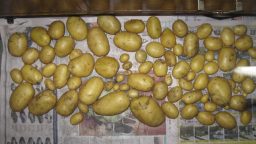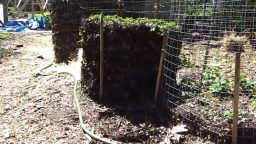Potatoes are such a great garden crop, if you can manage to grow them. They can keep for months throughout the winter, and are a great source of nutrients and calories. While they keep well in a dark, cool area like a root cellar or even a garage, there is a very important step you must take before storage: curing.
What is curing?
Curing potatoes is essentially letting them dry out before storing away. There are several advantages to curing:
- All wet spots dry out that might otherwise contribute to rot
- The skins will harden, allowing the potatoes to keep for much longer
- Damaged spots of the potatoes can heal
- You get a chance to inspect all of your potatoes and sort out the bad ones
- You can sort by size and type, if desired
How to cure potatoes
It’s really very simple to cure potatoes, if you follow a few easy guidelines. The process is pretty simple, to start, you want to spread all your potatoes out on a surface, ideally covered with newspaper or torn up paper bags, and let sit for about 10 days or so.
Air flow is the number one factor when choosing where and how to cure your potatoes. You want the potatoes to get plenty of air flow between each of them so spread them out, and you also want to be doing this in a well-ventilated area. In a well-ventilated garage or basement with a small fan, for example, might be ideal, but of course, since this might take up a lot of room you might have to improvise.
Keep it dark: the darker this area, the better. You will of course have to turn on the light to check your potatoes from time to time and this won’t hurt, but don’t set up in an area that has a lot of windows and regular, 12-hour daylight. Light will ruin your potatoes.
Keep it cold, as cooler temperatures, below 60 degrees, will keep the potatoes fresh and move along the curing process.
Once your potatoes are all dried out, and this might involve inspecting them pretty carefully, they’re ready to store! There are multiple ways to store potatoes (which we might have to cover at some point in the future!) but the same rules for curing apply: somewhere dark, cool, and with decent airflow. If your curing was successful, they’ll keep for months!
If you enjoyed this, you might also like….




